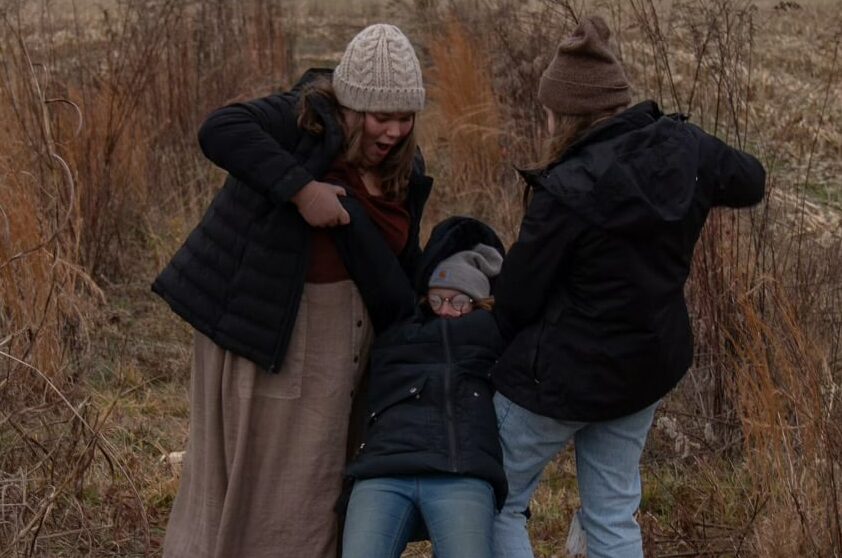Written by Levi Bareither, Development Coordinator, Story International
“A dusty ceiling fan creaks into motion, and two dozen eyes turn upward, transfixed. The air, thick and musty, begins to whirl around the windowless room, doing nothing to help with the smell. Moments later a television hung high up on the wall comes to life, animal characters dancing across the screen. 22 eyes dart towards the flashing light in synchrony, as if pulled by a magnet.
The last pair of eyes look desperately out the side of a metal crib, following the tall figure who has just entered the room.
As the figure walks past, a whine sneaks out of the tiny lips and the anguished eyes begin to water. The whine turns into a cry, and the baby reaches toward the figure, who stops, checking her diaper and temperature before putting her back down and proceeding to check the other diapers and prepare formula for her and the others. The crying continues, but eventually exhaustion wins.
She’s new here, after all, and in a few months her eyes will fall in line with the rest.”
Sounds like the start to a dystopian science fiction novel, doesn’t it?
Deinstitutionalization, apart from being one of the most difficult words to pronounce in Spanish (11 syllables!), is probably one of the most important words in contemporary global development.
While every crisis from poverty to infectious diseases to armed conflict is urgent, few have the potential to cause more multi-generational devastation than the over-institutionalization of children (estimates range from 2-8+ million) around the globe.
With about 80% of “orphans” globally having at least 1 living parent, fewer still are as easily preventable.
The picture painted above, while fictional, gives you a glimpse of what a “baby room” might look like at an orphanage or institution. While the setting itself is bleak, what we’ve really got to pay attention to are those eyes, and the babies whose critical need for stimulation and attention have been so neglected that they don’t even cry anymore.
It wouldn’t be fair to pin this on orphanage staff, who may be given the impossible task of caring for 10+ babies who have already experienced significant trauma. The problem is the model itself.
An orphanage cannot raise a child. Only a family can do that.
The first one thousand days of a child’s life—from conception till age 2—is the “critical window” for development, laying the groundwork for the rest of their life, and determining things such as intelligence, physical growth, social connectability and emotional resilience.
Getting it right is kind of a big deal.
The earlier institutionalization is addressed the sooner the damage can be mitigated.
In a report titled “The Risk of Harm to Young Children in Institutional Care”, author Kevin Browne mentions the tragic case of a 2 year old girl who would scratch herself and pull her hair to get attention. When it worked, she did it more, till it got to the point that they tied her up in her bedding so she couldn’t self harm.¹
Can you imagine her desperation?
Stop a moment and try. I know, it’s probably uncomfortable.
This—this is why deinstitutionalization matters. It’s for the baby who doesn’t cry anymore.
It’s for the child who gets in trouble on purpose so that someone notices him.
It’s for the teen girl who cuts herself to self-medicate.
It’s for the boy who’s looking for belonging and thinks a gang might offer it.
It’s for all of the millions of children who should hear “I love you” today, but won’t, and have no idea when or where they might hear it.
A report by the Lancet Group noted that less than ¼ children living in institutions (24%) have a secure attachment.² Without a secure attachment, children of all ages are set up to struggle through life, and find themselves at a much greater risk for things like prostitution, crime, illness, and even suicide.
In Guatemala, there are few alternative care options for children separated from family. If there isn’t another family or community member to take them in, they’ll likely end up in an orphanage or in the streets.
That’s why Story International is working so hard to preserve families, build out a foster care network as a safer alternative to orphanages and institutions, and educate the local church and future professionals in social work and psychology about the importance and urgency of family-based care.
Because these children NEED family.
Every day is precious.
Every day is urgent.
Every day is crucial.
Let’s keep fighting for a world where every child has a place to call home.
Sources:
http://learn.viva.org/wp-content/uploads/2017/08/The_Risk_of_Harm.pdf
https://www.thelancet.com/journals/lanpsy/article/PIIS2215-0366(19)30399-2/fulltext



